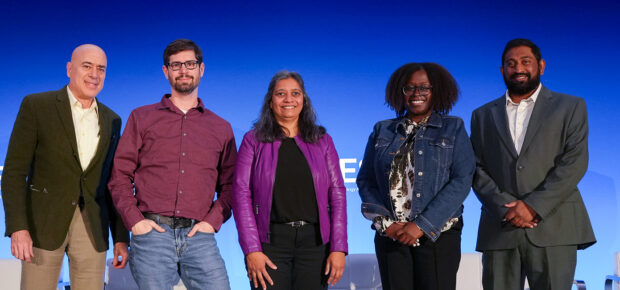January 15, 2025
Artificial intelligence is both powerful and mesmerizing. It can automate mundane tasks that most of us would rather avoid and create powerful images that captivate the imagination.
But those capabilities come with a cost. Training and deploying AI models require vast computational power, leading to significant energy consumption and a growing carbon footprint. Companies looking to deploy AI often cannot find candidates with relevant expertise. And AI brings with it a host of other ethical concerns, including the rise of deepfakes, the value of intellectual property and the trustworthiness of AI systems.
The conflict between AI’s costs and its promise was front and center at a panel entitled “Can AI Deliver Technology for Good?” hosted by IEEE Spectrum Editorial Director Glenn Zorpette at the 2025 Consumer Electronics Show (CES) in Las Vegas. The panelists included IEEE Senior Members Hasala Dharmawardena and Nita Patel, alongside IEEE Members Mark Riedl and Gloria Washington.
You can watch the full discussion here. Check out some of the highlights:
How Large Language Models Work
You may have heard people say that large language models are simply systems that are very good at predicting the next word in a sentence. When you hear the word “blue” you might think of the word “berry.” But if you hear the phrase “deep blue” you might think the next word is “sea.” Large language models use context to predict the next word in a phrase or a sentence based on massive datasets, and lots of math. The explanation paved the way for a discussion about responsible use of AI, and why generative AI systems can provide incorrect answers.
“Every word that goes into a language model is a clue as to what’s going to come next,” Riedl said. “And with just three words, you can come up with a pretty good idea of what I’m going to say. Now if you have a hundred words or a thousand words, the word that’s going to come next becomes kind of self-evident. A language model tries to find the patterns in all of these words, all the clues, and how they might relate to what’s going to come next.”
How Much Energy Do AI Systems Use?
The more complex the large language model, the more energy it takes to generate text or images. U.S. energy consumption has remained relatively stable over the past two decades, despite population and economic activity increases. The panelists explained why the rise of artificial intelligence is expected to increase power consumption.
Emerging Use Cases
AI models are great at answering questions. They can even plan vacations for you, but there are limitations to their capabilities. While they can write out a plan, they can’t book a hotel room or choose a flight for that vacation. The next step for AI will likely be AI agents capable of writing out a plan and putting it into motion. Agentic AI will also have a big impact on fields like healthcare, manufacturing, marketing and cybersecurity.
“For me, AI is about enabling humans to do more,” Patel said. “The idea of a calculator was very simple, but that enabled people to do a lot more. AI is like that for programming. You can say you want something to happen and then it’s created.”
Can AI Deliver Technology For Good?
The answer, of course, is yes. However, panelists pointed out that AI is a dual-use technology, one that the user shapes. Ultimately, it’s about striking a balance between innovative development and the need for human oversight and thoughtful policies to guide its development and use.
“Everything is wonderful with these technologies, but oftentimes, underrepresented and marginalized groups are affected in ways we don’t anticipate,” said Washington. “We need to truly think through fairness, accountability and transparency when we develop and deploy these tools.”






 Meaningful Momentum or Running in Place?
Meaningful Momentum or Running in Place? AI Through Our Ages
AI Through Our Ages Liquid Infrastructure: Our Planet's Most Precious Resource
Liquid Infrastructure: Our Planet's Most Precious Resource The Impact of Technology in 2025
The Impact of Technology in 2025 Quantum and AI: Safeguards or Threats to Cybersecurity?
Quantum and AI: Safeguards or Threats to Cybersecurity? Why AI Can't Live Without Us
Why AI Can't Live Without Us Bits, Bytes, Buildings and Bridges: Digital-Driven Infrastructure
Bits, Bytes, Buildings and Bridges: Digital-Driven Infrastructure Impact of Technology in 2024
Impact of Technology in 2024 Emerging AI Cybersecurity Challenges and Solutions
Emerging AI Cybersecurity Challenges and Solutions The Skies are Unlimited
The Skies are Unlimited Smart Cities 2030: How Tech is Reshaping Urbanscapes
Smart Cities 2030: How Tech is Reshaping Urbanscapes Impact of Technology 2023
Impact of Technology 2023 Cybersecurity for Life-Changing Innovations
Cybersecurity for Life-Changing Innovations Smarter Wearables Healthier Life
Smarter Wearables Healthier Life Infrastructure In Motion
Infrastructure In Motion The Impact of Tech in 2022 and Beyond
The Impact of Tech in 2022 and Beyond Cybersecurity, Technology and Protecting Our World
Cybersecurity, Technology and Protecting Our World How Technology Helps us Understand Our Health and Wellness
How Technology Helps us Understand Our Health and Wellness The Resilience of Humanity
The Resilience of Humanity Harnessing and Sustaining our Natural Resources
Harnessing and Sustaining our Natural Resources Creating Healthy Spaces Through Technology
Creating Healthy Spaces Through Technology Exceptional Infrastructure Challenges, Technology and Humanity
Exceptional Infrastructure Challenges, Technology and Humanity The Global Impact of IEEE's 802 Standards
The Global Impact of IEEE's 802 Standards Scenes of our Cyber Lives: The Security Threats and Technology Solutions Protecting Us
Scenes of our Cyber Lives: The Security Threats and Technology Solutions Protecting Us How Millennial Parents are Embracing Health and Wellness Technologies for Their Generation Alpha Kids
How Millennial Parents are Embracing Health and Wellness Technologies for Their Generation Alpha Kids Space Exploration, Technology and Our Lives
Space Exploration, Technology and Our Lives Global Innovation and the Environment
Global Innovation and the Environment How Technology, Privacy and Security are Changing Each Other (And Us)
How Technology, Privacy and Security are Changing Each Other (And Us) Find us in booth 31506, LVCC South Hall 3 and experience the Technology Moon Walk
Find us in booth 31506, LVCC South Hall 3 and experience the Technology Moon Walk Virtual and Mixed Reality
Virtual and Mixed Reality How Robots are Improving our Health
How Robots are Improving our Health IEEE Experts and the Robots They are Teaching
IEEE Experts and the Robots They are Teaching See how millennial parents around the world see AI impacting the lives of their tech-infused offspring
See how millennial parents around the world see AI impacting the lives of their tech-infused offspring Take the journey from farm to table and learn how IoT will help us reach the rising demand for food production
Take the journey from farm to table and learn how IoT will help us reach the rising demand for food production Watch technical experts discuss the latest cyber threats
Watch technical experts discuss the latest cyber threats Explore how researchers, teachers, explorers, healthcare and medical professionals use immersive technologies
Explore how researchers, teachers, explorers, healthcare and medical professionals use immersive technologies Follow the timeline to see how Generation AI will be impacted by technology
Follow the timeline to see how Generation AI will be impacted by technology Learn how your IoT data can be used by experiencing a day in a connected life
Learn how your IoT data can be used by experiencing a day in a connected life Listen to technical experts discuss the biggest security threats today
Listen to technical experts discuss the biggest security threats today See how tech has influenced and evolved with the Games
See how tech has influenced and evolved with the Games Enter our virtual home to explore the IoT (Internet of Things) technologies
Enter our virtual home to explore the IoT (Internet of Things) technologies Explore an interactive map showcasing exciting innovations in robotics
Explore an interactive map showcasing exciting innovations in robotics Interactively explore A.I. in recent Hollywood movies
Interactively explore A.I. in recent Hollywood movies Get immersed in technologies that will improve patients' lives
Get immersed in technologies that will improve patients' lives